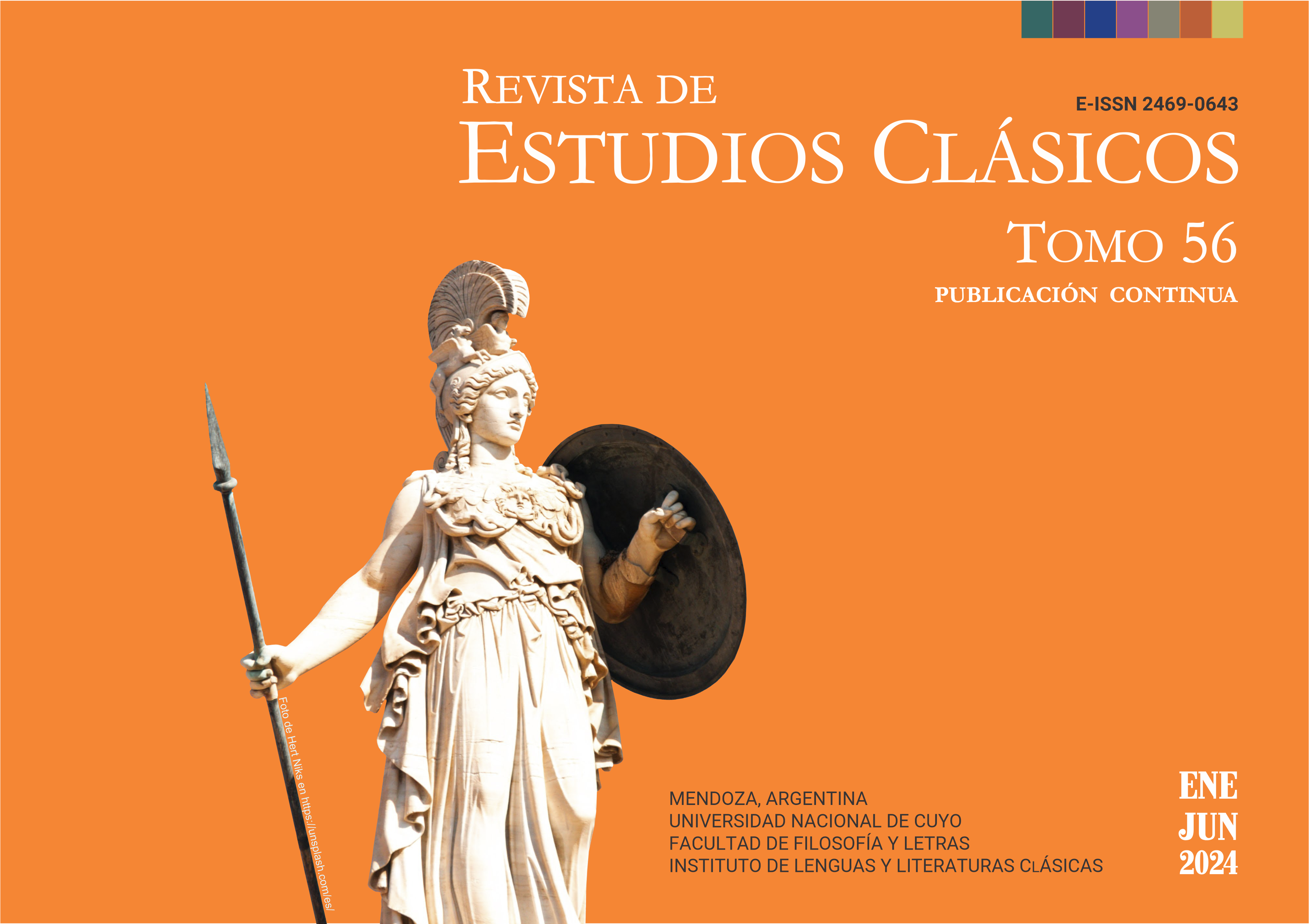Timarión acerca del vello: tres tipos
Palabras clave:
período Bizantino , Timarión , catábasis, vellosidad, diatribaResumen
This article consists of two sections. The first delimits and contextualizes the topos in question, regarding hairiness in literature. The second presents a reflection on the meanings that include the capillary appearance of three figures from the anonymous Byzantine opusculum of the XII century written in ancient Greek, Timarion. In the case of a historical period convulsed in sociocultural, political, and religious terms, literary fiction in a syncretism of elements from classical Antiquity / paganism reinvented and adapted, mutatis mutandis, in the Judeo-Christian paradigm is a necessary mask to transmit messages of Lucian nature regarding multidimensional criticism with a playful tone. The three hair domains analyzed (capillary, mandibular, anal) constitute an enigma that, after filtration, reveals multiple purposes of relevance to the Byzantine context.
Citas
Alexiou, M. (2002). After Antiquity: Greek Language, Myth, and Metaphor. Ithaca: Cornell University Press.
Allen, T. (ed.). (1946). Homeri Opera, Vol. 5. Oxford: Oxford University Press.
Batten, A. (2009). Neither Gold nor Braided Hair (1 Timothy 2.9; 1 Peter 3.3): Adornment, Gender and Honour in Antiquity. NT 55(4): 484-501.
Chapman, H. y Kim, D. y Suskind, J. y Anderson, A. (2009). In Bad Taste: Evidence for the Oral Origins of Disgust. Science 323: 1222–1226.
Dräseke, J. (1897). Michael Psellos im Timarion. BZ 6: 483-490.
Dunn, F. (1996). Tragedy's End: Closure and Innovation in Euripidean Drama. New York: Oxford University Press.
Gantz, T. (1993). Early Greek Myth. A Guide to Literary and Artistic Sources. Baltimore y London: The Johns Hopkins University Press.
Kaldellis, A. (2008). Hellenism in Byzantium: The Transformations of Greek Identity and the Reception of the Classical Tradition. Cambridge: Cambridge University Press.
Kaldellis, A. (2012). The Timarion: Toward a Literary Interpretation. En P. Odorico (ed.). La face cachée de la littérature byzantine: le texte en tant que message immédiat - Actes du colloque international 5-6-7 juin 2008 (pp. 275–287). Paris: Centres d'études byzantines, néo-helléniques et sud-ouest européenes, École des hautes études en sciences sociales.
Keller, O. (1887). Thiere des classischen Alterthums. Innsbruck: Verlag der Wagner'schen Universitäts-Buchhandlung.
Kilmer, M. (1982). Genital Phobia and Depilation. JHS 102: 104–112.
Kimball, P. ed. (2010). The Third Sophistic: New Approaches to Rhetoric in Late Antiquity. Journal of Late Antiquity 3: 262-263.
Kirkpatrick, J. y Dunn, F. (2002). Heracles, Cercopes, and Paracomedy. TAPhS 132 (1/2): 29–61.
Kucharski, J. y Marciniak, P. (2017). The beard and its philosopher: Theodore Prodromos on the philosopher’s beard in Byzantium. Byzantine and Modern Greek Studies 41: 45–54.
MacDougall, B (2016). The Festival of Saint Demetrios, the Timarion, and the Aithiopika. Byzantine and Modern Greek Studies 40.1: 135–150.
Marciniak, P. (2020). Of false philosophers and inept teachers: Theodore Prodromos’ satirical writings (with a translation of the poem Against the old man with a long beard). Βυζαντινά Σύμμεικτα 30: 131-148.
Olson, K. (2014). Masculinity, Appearance, and Sexuality: Dandies in Roman Antiquity. JHSex 23(2): 182-205.
Pernot, L. (2021). The Third Sophistic. Rhetorica 39(2): 174-176.
Perrot, G. y Chipiez, C. (1884). Histoire De L’art Dans l’antiquité – Phénicie – Egypte – Assyrie – Judée – Asie Mineure – Perse – Grèce. Paris: Librairie Hachette et Cie.
Polemis, D (1968). The Doukai: A Contribution to Byzantine Prosopography, Demetrios I. London: Athlone Press.
Quiroga, A. (2007). From Sophistopolis to Episcopolis: The Case for a Third Sophistic: Journal of Late Antique Religion and Culture 1: 31–42.
Romano, R. (1991). Costantino Acropolita, Epistole, carta 91. Nápoles: M. D'Auria.
Trizio, M. (2013). Trials of Philosophers and Theologians under the Komnenoi. En A. Kaldellis y N. Siniossoglou (eds.). The Cambridge Intellectual History of Byzantium (pp. 462-476). Cambridge: Cambridge University Press.
Vasiliev, A. (1952). History of the Byzantine Empire 324-1453. Madison: University of Wisconsin Press.
Vitanza, V. (1991). Some More Notes, Towards a Third Sophistic. Argumentation 5: 117–139.
Vyronis, S. (1981). The Panegyris of the Byzantine Saint: A Study in the Nature of a Medieval Institution, its Origins and Fate. En S. Hackel (ed.). The Byzantine Saint (pp. 196-228). Birmingham: University of Birmingham.
Watson, P. (2005). ‘Non Tristis Torus et Tamen Pudicus:’ The Sexuality of the ‘Matrona’ in Martial. Mnemosyne 58(1): 62–87.
Descargas
Publicado
Cómo citar
Número
Sección
Licencia
Derechos de autor 2024 Reina M. Troca PereiraAquellos autores/as que tengan publicaciones con esta revista, aceptan los términos siguientes:
- Los autores/as conservarán sus derechos de autor y garantizarán a la revista el derecho de primera publicación de su obra, el cuál estará simultáneamente sujeto a laLicencia Creative Commons Atribución-NoComercial-CompartirIgual 2.5 Argentina (CC BY-NC-SA 2.5 AR). (https://creativecommons.org/licenses/by-nc-sa/2.5/ar/)que permite a terceros compartir la obra siempre que se indique su autor y su primera publicación esta revista.
- Los autores/as podrán adoptar otros acuerdos de licencia no exclusiva de distribución de la versión de la obra publicada (p. ej.: depositarla en un archivo telemático institucional o publicarla en un volumen monográfico) siempre que se indique la publicación inicial en esta revista.
- Se permite y recomienda a los autores/as difundir su obra a través de Internet (p. ej.: en archivos telemáticos institucionales o en su página web) antes y durante el proceso de envío, lo cual puede producir intercambios interesantes y aumentar las citas de la obra publicada. (Véase El efecto del acceso abierto).












